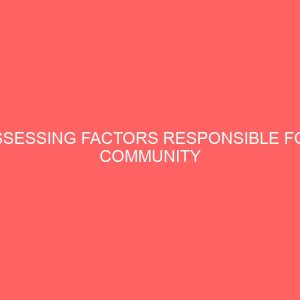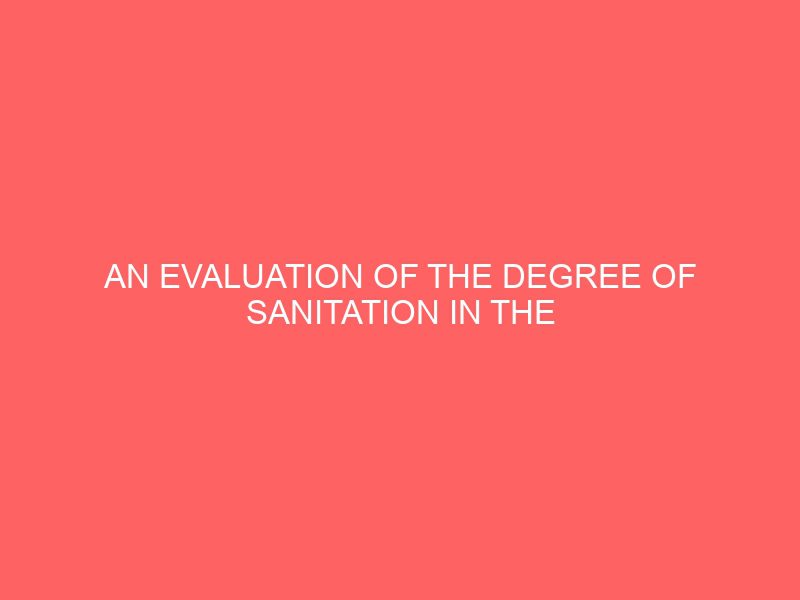Description
CHAPTER ONE 1.0 INTRODUCTION The environmental sanitation has become a prominent but complex and multi-dimensional issue on the public policy agenda of states and international organizations. This transformation after a long period of benign neglect began in Rio in 1992. The issue of the environmental sanitation is today perceived not simply as a narrow ecological problem of how to ensure a symbiotic inter-face between man and the environment. Its inner core has psychological, political, developmental, sociological and scientific ramifications, all of which are anchored to the new concept. As the 2015 target date is being approached for the Millennium development Goals (MDGs), WHO and UNICEF are monitoring and addressing the current challenges and those that lie ahead. The United Nations Economic Commission for Africa (UNECA) latest update on Africa’s progress in achieving the Millennium Development Goals (MDGs) reports that, Africa is making some progress on MDG 7, which is to ensure environmental sustainability. Currently, Nigeria is part of the countries whose sanitation coverage rates are between 20% and 40 % points below the MDG targets. Even though, effort has been made by government agencies, local organizations to increase access to sustainable sanitation in major cities in Nigeria; by supporting the provision of improved sanitation facilities in schools and rural communities thereby contributing to the achievement of the national target of 90% by 2015 and 100% by large numbers of both urban and rural areas still lack access to adequate sanitary facilities like latrines, hand washing facilities and waste disposal facilities. Non- availability of sustained, effective and safe services is common experience for many developing countries around the world and has resulted into a high prevalence of sanitation related diseases, causing many people; children in particular, to fall ill or even die. The standard of sanitation facilities reflects the socio-economic development of a nation. Sanitation is essential for human health, generates economic benefits and contributes to dignity and socio-economic development. In fact, the type of access and quality of sanitation supply, as well as quality of sanitation facilities available to households or communities determine their quality of life. Unfortunately, in Nigeria many still live in poor sanitary conditions and do not maintain proper standards of hygiene. Invariably, better sanitation will lead to reduction of diseases, human suffering and enhance productive capacities in addition to reduction in health care cost. Good sanitation contributes to low level of child mortality, it was estimated that over 10 million productive days would be gained if access to both sanitation in Nigeria rose to 100 percent. It was situated that Government often run out of funding because of political or economic shifts, thereby jeopardizing the success of sanitation projects. Expressed that there is need for increased attention to monitoring, which should include transparency and accountability, and assessing where funding comes from and how it is being used. In Nigeria, 2.5 billion people lacked access to an improved sanitation facility, 761 million use public or shared sanitation facilities, 693 million use facilities that do not meet minimum standard of hygiene and 1 billion of the world population still practice open defecation especially those who live in rural areas. The inadequacy of safe and improved sanitation services is manifested in the prevalence of environmental related diseases especially among rural communities in Nigeria. The benefits of hygiene promotion are generally not prioritized and the costs of hygiene promotion are poorly understood and therefore not adequately budgeted for. 1.2 STATEMENT OF THE PROBLEM Ethically, the beauty of any environment lies on its good sanitary condition. This is so because, when an environment is clean, the lives of the citizenry are not threatened by illness and diseases. Proper refuse disposal management involves the dumping of wastes (solid, liquid or gaseous) from our homes, industries and public outfits at a specific place or in government provided containers and the control and removal of refuse from places where they can cause hazards to a place where they are less hazardous to public health. Eruwa metropolis as a case study of the research work presents a ghastly picture; the neglect of filled refuse bin in recent time has its effect on the inhabitants. Many areas around the homes are littered with domestic refuse sewage wastes which are toxic with negative impacts on our environment, land, water and air. Indiscriminate refuse dump affects quality of water and air of which the people seem not to be aware. Public Educational Programmes that enlighten the public on the health implication of indiscriminate refuse dump are almost non-existent. Mass Media seem not to be doing enough to create awareness about implications of bad environmental sanitation. It was against this background that the researcher embarked on this research to appraise the public health awareness of health implications of indiscriminate refuse dump in the Eruwa Metropolis. 1.3 OBJECTIVES OF THE STUDY The major objectives of the study is, 1) To find out whether inhabitants of Eruwa are aware of the implications of indiscriminate waste disposal in their environment. 2) To evaluate the level of efficiency in the control and management of rural waste in Eruwa 3) To investigate whether the methods proffered by the government are adequately creating awareness about health implications of indiscriminate waste disposal in Eruwa metropolis. 4) To identify various ways the environmentalist/policy makers could help in changing human behavior and responses to environmental options that will promote environmental sanitation. 1.4 RESEARCH QUESTIONS This study was designed to address the following questions 1) Do the inhabitants of Eruwa metropolis aware of the implications of indiscriminate waste disposal in their environment? 2) What is the level of efficiency of Eruwa metropolis rural waste control and management? 3) Are there any techniques proffered by government adequately creating awareness about health implications of poor rural waste management in Eruwa metropolis? 4) What ways could the environmentalist/policy makers help in changing human behaviours and responses to environmental options that will promote environmental sanitation? 1.5 SIGNIFICANCE OF THE STUDY The collection of refuse is irregular and inefficient in Eruwa metropolis. Litter and refuse often accumulated along roads and places, creating breeding ground for mosquitoes, flies, cockroaches and rodents responsible for the spread of many diseases. Drains were choked with refuse and there is open burning of waste everywhere. The results reveal whether the public are aware of the health implications on indiscriminative refuse dump in the environment. It also shows why governmental efforts may not be enough in solving environmental problem and why individuals must be involved. Government at all levels is involved in refuse disposal. Local, State and Federal governments each control a specific part of the process. Refuse disposal is generally seen as a municipal responsibility because of the landfill and recycling components. Though this obligation is more or less moral or attitudinal in outlook, but a clean environment will impact positively on Eruwa?s socio economic wellbeing of the citizens. The information will go a long way in helping the teachers, environmental educators and health educators will also benefit from the study in such a way that it would help them to emphasize the link between good health and clean environment. A workable solid sanitation strategy for Eruwa metropolis becomes dependent on a long team strategy for all citizens. 1.6 SCOPE OF THE STUDY The study is delimited to sanitation management in Eruwa metropolis, the study intends to investigate the people?s inability to maintain a sanitarily clean environment and to emphasize the link between good health and clean environment. The study covers some known dirty areas and dumping sites like, which included: The Akolu hills, Oke-Ola dumping site, and some other vicinities around the community. 1.7 DEFINITION OF TERMS 1) Waste: It is the leftovers, used products whether liquid or solid having no economic value or demand and which must be disposed. 2) Waste management: It refers to the act to maintain acceptable environmental quality, sound public health and creation of aesthetic value. 3) Environment: It refers to the total surroundings of humans that support life 4) Environmental sanitation: This is an intervention to reduce people exposure to disease by providing a clean environment in which to live. 5) Environmental health: It refers to the health implications of the interactions between individuals and their natural and built environment.







